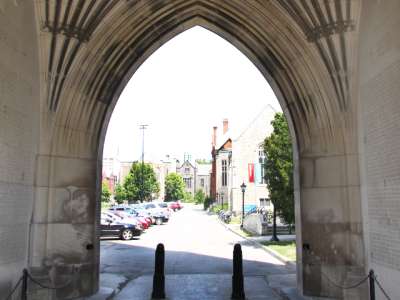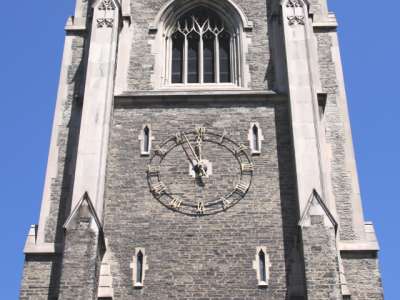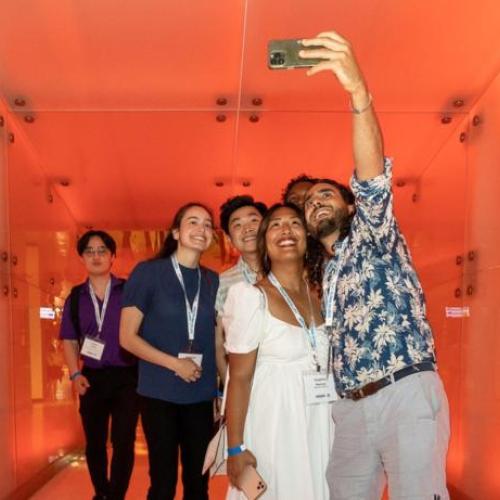Features of Soldiers’ Tower
Monument, museum and bell tower
Situated at the western end of Hart House and standing 43.5 metres (143 feet) tall, the Soldiers’ Tower is a memorial to the 628 members of the University of Toronto who gave their lives while on active service in 1914 to 1918 and to the 557 men and women lost from 1939 to 1945.
It was built in 1923 to 1924 using $397,141 raised by the University of Toronto Alumni Association to build a war memorial and establish scholarships in memory of those students, faculty, staff and alumni who served in the Great War. The initial cost of the Tower and memorial screen, the clock and the carillon was $252,500. The interest on the surplus is still in use today for War Memorial Scholarships and for Tower expenses.
The Tower exterior
Accessible to the public year-round.

Memorial screen
Carved in stone on the memorial screen are the ranks, names and units of those lost to the university in the First World War.
A complete transcription can be found at the National Inventory of Canadian Military Memorials >

Memorial arch
The two walls of the archway record the service of the men and women lost in the Second World War.
A complete transcription can be found at the National Inventory of Canadian Military Memorials >

Garden of Remembrance
The garden behind the memorial screen provides a place for quiet reflection.
The Tower interior
Stained glass windows, paintings, inscriptions and artifacts commemorate those who served and those who fell in the two World Wars.
Please note: The Soldiers’ Tower is a heritage building, the interior of which is not accessible to persons with certain disabilities. The stairwell to the Memorial Room is equipped with a stairlift. If you have a disability requiring accommodation we request that you contact us in advance so we can provide more detail and make your visit as accessible as possible.

Staircase of Honour
Eight stained glass windows commissioned by the Soldiers’ Tower Committee in 2005 honour Canadian forces in action during wartime. The men and women depicted have the rank of private or equivalent.
Shown here: (left) a radio operator at work in the Royal Canadian Air Force (Women's Division); (centre) a private soldier pays tribute to the fallen, who are portrayed in ghostly images, at the Vimy Memorial ( gift of Major Roy B. Oglesby); (right), a member of the Canadian Women's Army Corps sits at the wheel of a vehicle (gift of Major General Bruce Jarvis Legge, 4T1).
Memorial Room
Open to the public several times per week on an irregular schedule. Researchers or groups may also contact us for appointments outside of scheduled hours.

Memorial window
This beautiful stained glass window was commissioned for the Soldiers’ Tower and dedicated on November 6, 1995. Designed and built from hand-blown antique glass by The Russell C. Goodman Stained Glass Studio, of Parry Sound, its symbolism is based, in part, on John McCrae’s poem In Flanders Fields.
The victory torch in the centre stands for the attainment of peace and of hope. The maple leaf, rising above, represents the emergence of Canada as a nation devoted to freedom, understanding and world peace. The poppies at the foot of the crosses invoke remembrance. The four lower panels depict a sailor, a soldier, an airman, and a nursing sister representing the women of all three services.

Memorial books
Resting on a metal pedestal in the centre of the Memorial Room is the University of Toronto Roll of Service 1914-1918 and the Memorial Book for 1939-1945, which list those who perished in service to their country. The 1914-1918 Roll of Service also contains records of those who returned safely. It contains more than 6,000 names.
Portraits
Portraits of some illustrious graduates of this university are on display: Lt.-Col. John McCrae, who wrote In Flanders Fields; Major Thain MacDowell, VC, DSO, who earned the Victoria Cross in the battle of Vimy Ridge; Major Fred Tilston, VC, awarded the Victoria Cross for his efforts in Hochwald Forest (Germany), 1945; and the co-discoverers of insulin, Sir Frederick Banting and Charles Best. Both served in the Canadian Army in the First World War and contributed medical expertise in the second.

Inscriptions to carillon bells
The original 23 carillon bells were donated by U of T alumni and dedicated to members of the University who fell in the First World War. The dedicatory inscriptions are carved into the walls of the Memorial Room.
Artifact collection
The Memorial Room includes a collection of medals, photographs, flags and colours. These artifacts honour the memory and wartime service of the University’s students, faculty and staff who fought to preserve our liberties and democracy.

Clock
The clock was purchased in 1927, by the University of Toronto Alumni Association, from the British firm Gillett and Johnston, together with the original 23 bells of the carillon.

